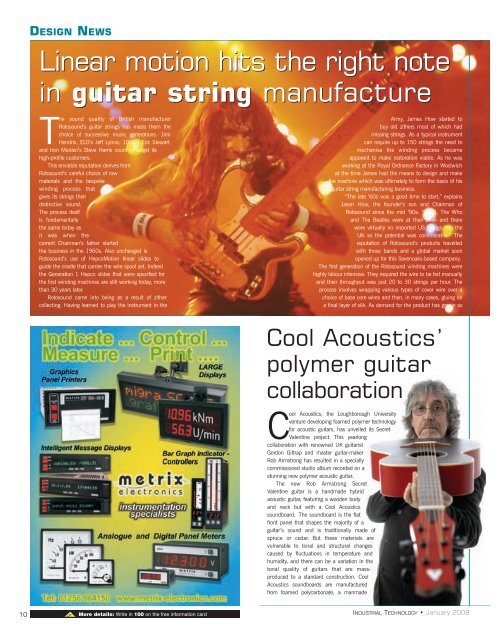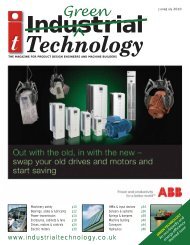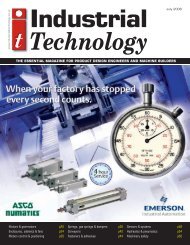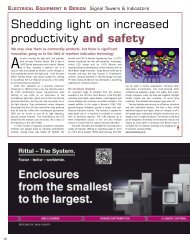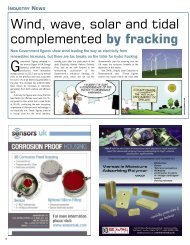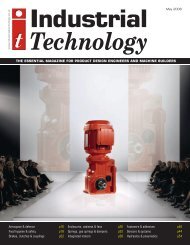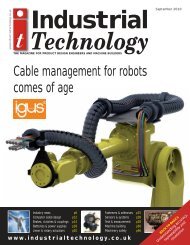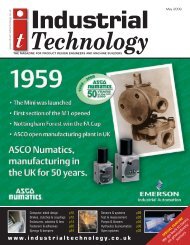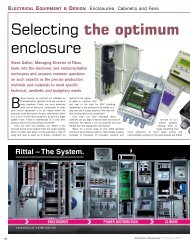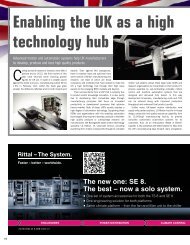IT Jan 2008 - Industrial Technology Magazine
IT Jan 2008 - Industrial Technology Magazine
IT Jan 2008 - Industrial Technology Magazine
You also want an ePaper? Increase the reach of your titles
YUMPU automatically turns print PDFs into web optimized ePapers that Google loves.
DESIGN NEWS<br />
Linear motion hits the right note<br />
in guitar string manufacture<br />
The sound quality of British manufacturer<br />
Rotosound’s guitar strings has made them the<br />
choice of successive music generations. Jimi<br />
Hendrix, ELO’s Jeff Lynne, 10CC’s Eric Stewart<br />
and Iron Maiden’s Steve Harris count amongst its<br />
high-profile customers.<br />
This enviable reputation derives from<br />
Rotosound’s careful choice of raw<br />
materials and the bespoke<br />
winding process that<br />
gives its strings their<br />
distinctive sound.<br />
The process itself<br />
is fundamentally<br />
the same today as<br />
it was when the<br />
current Chairman’s father started<br />
the business in the 1960s. Also unchanged is<br />
Rotosound’s use of HepcoMotion linear slides to<br />
guide the cradle that carries the wire spool set. Indeed<br />
the Generation 1 Hepco slides that were specified for<br />
the first winding machines are still working today, more<br />
than 30 years later.<br />
Rotosound came into being as a result of zither<br />
collecting. Having learned to play the instrument in the<br />
Army, James How started to<br />
buy old zithers most of which had<br />
missing strings. As a typical instrument<br />
can require up to 150 strings the need to<br />
mechanise the winding process became<br />
apparent to make restoration viable. As he was<br />
working at the Royal Ordnance Factory in Woolwich<br />
at the time James had the means to design and make<br />
the machine which was ultimately to form the basis of his<br />
guitar string manufacturing business.<br />
“The late ’60s was a good time to start,” explains<br />
Jason How, the founder’s son and Chairman of<br />
Rotosound since the mid ’90s. “Floyd, The Who<br />
and The Beatles were at their peak and there<br />
were virtually no imported US strings into the<br />
UK so the potential was considerable.” The<br />
reputation of Rotosound’s products travelled<br />
with those bands and a global market soon<br />
opened up for this Sevenoaks-based company.<br />
The first generation of the Rotosound winding machines were<br />
highly labour intensive. They required the wire to be fed manually<br />
and their throughput was just 20 to 30 strings per hour. The<br />
process involves wrapping various types of cover wire over a<br />
choice of base core wires and then, in many cases, gluing on<br />
a final layer of silk. As demand for the product has grown so<br />
Cool Acoustics’<br />
polymer guitar<br />
collaboration<br />
Cool Acoustics, the Loughborough University<br />
venture developing foamed polymer technology<br />
for acoustic guitars, has unveiled its Secret<br />
Valentine project. This yearlong<br />
collaboration with renowned UK guitarist<br />
Gordon Giltrap and master guitar-maker<br />
Rob Armstrong has resulted in a specially<br />
commissioned studio album recorded on a<br />
stunning new polymer acoustic guitar.<br />
The new Rob Armstrong Secret<br />
Valentine guitar is a handmade hybrid<br />
acoustic guitar, featuring a wooden body<br />
and neck but with a Cool Acoustics<br />
soundboard. The soundboard is the flat<br />
front panel that shapes the majority of a<br />
guitar’s sound and is traditionally made of<br />
spruce or cedar. But these materials are<br />
vulnerable to tonal and structural changes<br />
caused by fluctuations in temperature and<br />
humidity, and there can be a variation in the<br />
tonal quality of guitars that are massproduced<br />
to a standard construction. Cool<br />
Acoustics soundboards are manufactured<br />
from foamed polycarbonate, a manmade<br />
10<br />
More details: Write in 100 on the free information card<br />
INDUSTRIAL TECHNOLOGY • <strong>Jan</strong>uary <strong>2008</strong>


